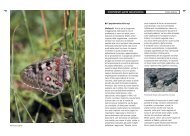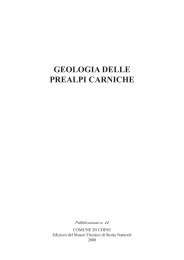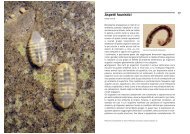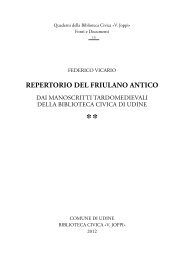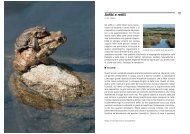Despite its inhospitable appearance and lack of any ... - Udine Cultura
Despite its inhospitable appearance and lack of any ... - Udine Cultura
Despite its inhospitable appearance and lack of any ... - Udine Cultura
Create successful ePaper yourself
Turn your PDF publications into a flip-book with our unique Google optimized e-Paper software.
68<br />
■ Decapods<br />
Italian fauna has only two stygobiont<br />
decapod genera living in karstic waters:<br />
Troglocaris (Isonzo <strong>and</strong> Trieste Karst)<br />
<strong>and</strong> Typhlocaris (Apulia). Recent<br />
research has revealed that Italian caves<br />
actually host two species <strong>of</strong> shrimps <strong>of</strong><br />
the genus Troglocaris <strong>of</strong> the<br />
anophthalmus group, morphologically<br />
difficult to distinguish, but easily<br />
Troglocaris anophthalmus<br />
identified by means <strong>of</strong> molecular<br />
biology techniques. They may belong<br />
to T. anophthalmus (Gorizia Karst) <strong>and</strong><br />
T. planinensis (Trieste Karst), although<br />
their taxonomy still requires<br />
Typhlocaris salentina<br />
confirmations. Stygobiont species <strong>of</strong><br />
the genus Troglocaris were thought to<br />
derive from marine ancestors. Very<br />
recent molecular biology analyses<br />
carried out at the University <strong>of</strong> Ljubljana<br />
(Slovenia) have dated the separation <strong>of</strong><br />
the western anophthalmus group from<br />
the Dinaric-Caucasian one at between<br />
6 <strong>and</strong> 11 million years ago, <strong>and</strong> the<br />
beginning <strong>of</strong> speciation within the<br />
anophthalmus group between 3.7 <strong>and</strong><br />
5.3 million years ago. Their marine origin is therefore very ancient, <strong>and</strong><br />
populations colonised groundwater coming from surface freshwater.<br />
The third species <strong>of</strong> Italian stygobiont decapods, Typhlocaris salentina, is<br />
endemic to Apulian caves. It was discovered in the Grotta Zinzulusa at Castro<br />
Marina in 1922, <strong>and</strong> later collected from other caves in Salento, Murge <strong>and</strong><br />
Gargano. This blind, depigmented prawn may reach exceptional sizes (up to<br />
13 cm); a predator, it feeds on mysidaceans <strong>and</strong> stygoxene organisms.<br />
The genus Typhlocaris includes two stygobiont species living in groundwater<br />
in Israel <strong>and</strong> Libya, suggesting that it is an ancient relict <strong>of</strong> an otherwise extinct<br />
palaeo-Mediterranean pre-Pliocene surface fauna associated with a subtropical<br />
climate. Unfortunately, molecular data on this genus are not yet<br />
available.<br />
■ Amphibians<br />
The olm (Proteus anguinus) is the only stygobiont amphibian <strong>of</strong> the Palaearctic<br />
fauna. The pétit dragon <strong>of</strong> the Postojna caves (Slovenia) - discovered by the<br />
Slovenian nobleman Valvasor in 1689 <strong>and</strong> briefly described by Laurenti in<br />
1768 - is the best-known underground animal described so far <strong>and</strong>, in some<br />
ways, the most fascinating. It has a pinkish-white eel-shaped body, with<br />
atrophic eyes concealed under the skin <strong>and</strong> outer red gill plumes which it<br />
retains throughout <strong>its</strong> life. The olm is known for <strong>its</strong> neoteny, i.e., it reaches<br />
precocious reproductive maturity despite <strong>its</strong> larval <strong>appearance</strong>. Olms are<br />
predators feeding on other aquatic, even stygoxene animals; the females lay<br />
between 20 <strong>and</strong> 80 eggs, one at a time for over one month, <strong>and</strong> place them<br />
under rocks <strong>and</strong> stones. The greyish tadpoles have distinct eyes, which they<br />
retain until they are two months old. Until the age <strong>of</strong> three months, olms feed<br />
exclusively on yolk stored in the cells <strong>of</strong> their digestive tracts. In nature,<br />
reproduction seldom occurs before the tenth year <strong>of</strong> age.<br />
The origin <strong>of</strong> olms is debated. Fossils <strong>of</strong> proteids <strong>and</strong> iguanodonts, found at<br />
Bernissart in Belgium, date back to the Lower Cretaceous, when olms lived in<br />
surface water. Their colonisation <strong>of</strong> karstic groundwaters in the Dinaric area<br />
where they now live may have started in the Pliocene, when karstification<br />
began. In 1994, in the Slovenian Karst, a pigmented, eyed subspecies was<br />
Olms also live in the groundwaters <strong>of</strong> the Isonzo Karst<br />
69




